英式早餐是世界第一美味早餐嗎?
- 2015年 7月 13日
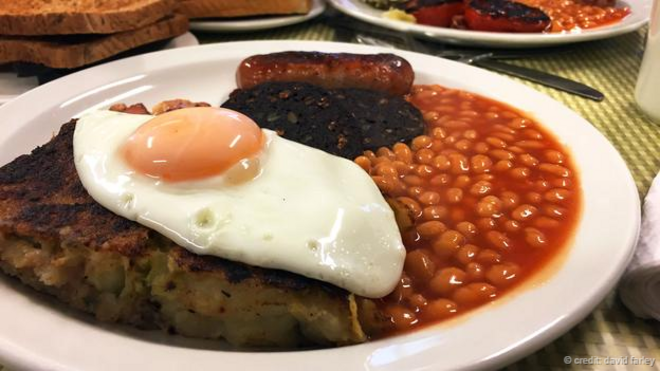
英國戲劇家薩默塞特·毛姆(Somerset Maugham)曾說過,「要在英國吃得好,就應該一天吃三頓早餐。」
這難道是變著法兒地影射除早餐外的英國食物都令人難以下咽嗎?或者說,英式早餐之美味值得讓人一天吃三次而不是一次?
英式早餐含有大量膽固醇和熱量,通常包括:兩個雞蛋、香腸、培根、焗豆、炸番茄和烤麵包。英式早餐之豐盛可以稱得上是饕餮大餐,吃一頓這樣的早餐,對付再糟糕的宿醉也不在話下,吃完了就算直接扛到吃晚餐也不成問題。但要是像毛姆說的那樣常常沉溺於英式早餐可是會折壽的。不過,英式早餐的忠實擁躉們堅持認為,除了在英國,在哪兒也找不到更好的早餐。
在最近的一次倫敦之行中,我想要盡情享用一下這些油煎食物(英式早餐的俗稱),親自驗證英式早餐究竟是不是世界第一美味早餐,另外,對毛姆的飲食箴言也能有個深入的認識。
皮姆利科(Pimlico)附近的攝政咖啡(Regency Café)自1946年起就一直供應全套英式早餐。為完成這項頗為艱巨的任務,我招募了當地一位美食評論人——莉齊·馬博特(Lizzie Mabbott),請她和我一起,冒著動脈硬化的危險,完成這次美食品鑒大冒險。
當我們走進咖啡廳時,正好有一個眼圈黑黑的家伙大步走出去,胳膊下夾著份報紙,這不禁讓我對自己是否真的要吃下整份早餐感到有些懷疑。馬博特和我排著隊研究吧台後黑板上的菜單:全套早餐包括雞蛋、培根、香腸、焗豆或番茄、麵包或吐司、咖啡或茶。價格總共是5.50英鎊。再加一點兒錢, 還能外加炸土豆餅、黑布丁(裝有小塊豬油的血腸)以及「嘰嘰咕咕」(一種捲心菜土豆餡餅)。
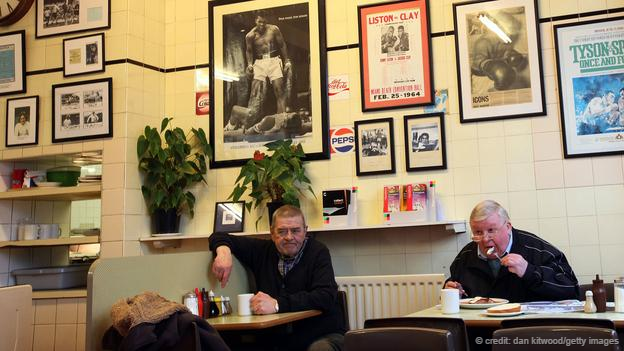
咖啡廳的內部裝修很簡單:塑料貼面桌子,塑料椅子,牆壁上塗有拳擊紀念圖片。吧台後優雅的女服務生大聲報著訂單:「番茄套餐!焗豆套餐加炸薯條!」我們也點了餐,我點了有黑布丁套餐外加「嘰嘰咕咕」。
在等待上菜時,馬博特告訴我她對油煎食物的個人吃法原則。「布朗沙司和番茄醬味道截然不同, 我會在香腸上塗布朗沙司,在其他油煎食物上都塗番茄醬。」馬博特又補充道,「但這還不夠,我不喜歡蛋黃沾上番茄,有這樣抱怨的人還真不少見。」
馬博特沒錯,她不是惟一有油煎食物原則的人。
在 BBC TV 長期欄目艾倫秀(「I』m Alan Partridge」)中,演員史蒂夫·庫根(Steve Coogan)就曾表示,上菜時煎蛋和焗豆應分開。在節目中,他的俄羅斯女友為他做傳統英式早餐。庫根表示,「也許我會把它們混起來吃,但我希望這是我自己決定的。」
儘管這有些可笑,但卻是實話。對細節特別挑剔的人並不少見,就像這次我餐桌對面的人。
馬博特催促我研究香腸,她認為只有香腸才能反映出早餐的整體質量。她說,「香腸做得好,盤子中的其他東西應該就沒什麼問題了。」攝政咖啡的香腸好得出奇:對這樣一家不怎麼在乎食品健康意識的餐廳而言,其香腸不僅新鮮多汁,而且經濟實惠。整體而言,早餐好得超出我的預期。不足之處是,黑布丁有些幹。另外,酸酸的番茄也幫我化解了培根的油膩。「嘰嘰咕咕」(夾著幾片捲心菜的半軟土豆餅)雖有些乏味,但卻也吸收了溏心煎蛋稀溜溜的蛋黃。
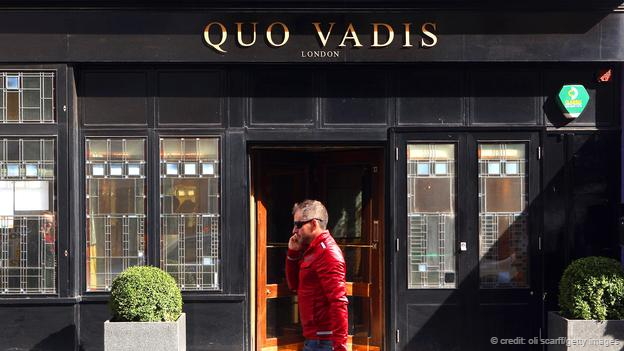
據英式早餐協會(The English Breakfast Society)(一家倫敦非營利組織,「致力於維護全英式早餐的歷史和傳承」)稱,煎炸食物還要追溯到19世紀初,當時,英國鄉村貴族在狩獵前或者休閒和閱讀之前,往往喜歡享用一頓豐盛的早餐。此後,隨著19世紀中產階級的出現,越來越多的英國人開始模仿富人的生活方式,全套英式早餐就是其中一個方面。在認識到一頓豐盛的早餐是一天繁重生活的良好開端之後,工人階級很快也加入其中。到1950年代,煎炸食物已經成為英國的國民早餐。
鑒於英式早餐的貴族血統,我也想要嘗試一下高端英式早餐的滋味。根據倫敦美食家(Food Lovers London)的作者、倫敦美食評論人詹妮·林福德(Jenny Linford)建議,倫敦蘇活區(Soho)的Quo Vadis餐廳就供應這樣的高端美食。這家高檔餐廳主要提供現代英倫美食。
這家餐廳裏靜謐的氣氛給人的感覺像是來到了酒店的大堂或者是沉悶的俱樂部一樣。這裏全套早餐價格高達12英鎊,除了不包括焗豆外,其他與我先前體驗過的英式早餐也沒有什麼不同。林福德表示,「這種豪華早餐最大的不同點是,食材質量要好很多。」
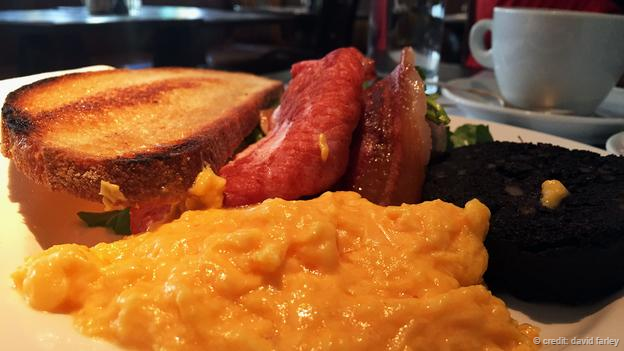
其中包括:與攝政咖啡幹幹的黑布丁不同,Quo Vadis餐廳的布丁外脆裏糯。培根也更為多汁和鮮嫩。煎蛋則是明亮的橘黃色。
林福德說,「我建議來這裏的原因在於,它能體現英倫美食的若干發展趨勢,這在盤子中就已一覽無餘。」她補充說,「優質美食基本上要在悠閒的環境裏享用,並且要用本地應時的食材製作。過去,你很可能必須去酒店才能享用到優質的全套英式早餐。現在的情況可不是這樣的了。」
在倫敦逗留的最後一天,在所住的南肯辛頓區(South Kensington)里程碑酒店(Milestone Hotel),我信步前往早餐區,看到了一份全套英式早餐菜單。我有點兒不情願地點餐:這已經是我一連第三天吃這樣容易導致動脈硬化的食物了。酒店的英式早餐值得一試嗎?我決定試一試再說。
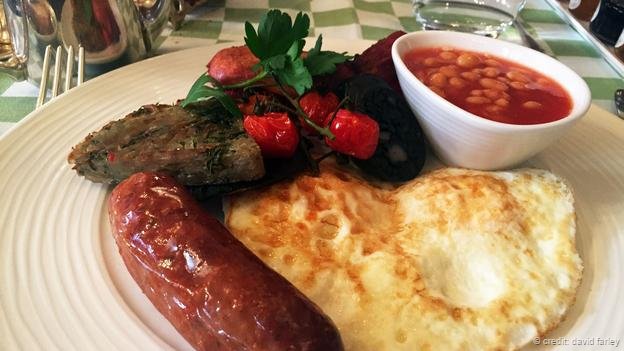
幸虧我這麼做了。這裏供應的早餐包括:兩種培根(都是外脊和五花培根),焗豆,可口的「嘰嘰咕咕」,鬆軟香糯的黑布丁,表皮緊實、內裏多汁的香腸,還有完美的溏心煎蛋。實際上,在我試吃的三次早餐中,這次是我的最愛。價格雖然不便宜,要25英鎊,但味道極好,就好像取自上好的食材一樣。實在是物有所值啊。
在吃過這麼多英式早餐後,我想知道的是自己能否平安返回紐約:我該不會在大西洋上空心臟病發作吧。但我的確對毛姆的妙語有了更深入的認識。毛姆於1965年離世,他要是活到現在,對英國食物的現狀也應該感到滿意,因為現在比那時候可要好出太多了。但我認為,毛姆必須說些讚美英式早餐的話,他也不會去攻擊英國美食。如果不是擔心熱量和膽固醇太高,英式早餐真的是值得一天吃三頓的。
請訪問 BBC Travel閱讀 英文原文。
(責編:路西)

Does England make the world’s most delicious breakfast?
This cholesterol-laden calorie bomb wards off the worst hangover and fills you up until dinner.
By David Farley9 July 2015

British playwright Somerset Maugham once said that “to eat well in England you should eat breakfast three times a day”.
Was this a witty way of saying that, save for breakfast, the food in England was inedible – or that the English breakfast is so superior that it’s worth eating not once but thrice daily?
The English breakfast is a cholesterol-laden calorie bomb usually consisting of two eggs, sausage, bacon, baked beans, fried tomato and toast. It’s a symphony of deliciousness on a plate, enough to ward off the worst hangover and fill you up until dinnertime. Indulge in it as often as Maugham suggested and it could take years off your life. But devotees insist you can’t find a better breakfast anywhere.
On a recent trip to London, I wanted to indulge in a few of these fry ups (as the meal is colloquially referred) to decide for myself whether this was the world’s best breakfast – and, by extension, how to interpret Maugham’s dining admonition.
Regency Café, in the Pimlico neighborhood, has been slinging up the full English breakfast since 1946. I recruited local food writer Lizzie Mabbott for the artery-hardening task of helping me decipher the dish.
As we walked in, a guy with a fresh black eye strode out, newspaper under his arm, making me wonder if I, too, was going to have to do battle to eat the entire meal. Mabbott and I got in line and studied the chalkboard behind the counter: the set breakfast consisted of egg, bacon, sausage, beans or tomatoes, bread or toast, coffee or tea. All for £5.50. For a small additional fee you could also order hash browns, black pudding (blood sausage stuffed with small chunks of lard) and bubble and squeak (a sort of potato cake with cabbage).
The café’s interior was simple: Formica tables, plastic chairs and walls plastered with boxing memorabilia. A dainty woman behind the counter barked orders in a booming voice: “Set tomato! Set beans with chips!” We ordered, and I got the set with black pudding and bubble and squeak.
As we waited, Mabbott let me in on her own personal fry-up rules. “Hotly contested is the brown-sauce-versus-tomato-sauce debate. I put brown sauce on the sausage and tomato sauce on anything that’s fried.” That wasn’t all, though. “I don’t like my egg yolk touching my tomato,” she said, adding, “and that’s not an uncommon complaint.”
Mabbott is right: she’s not the only one with fry-up rules.
According to I’m Alan Partridge, the long-running BBC TV show featuring actor Steve Coogan, the eggs and beans should be separate when served. “I may want to mix them, but I want that to by my decision,” Coogan said on an episode in which his Russian girlfriend makes him a traditional English breakfast. “And use the sausage,” he added, “as a breakwater.”
It’s funny because it’s true. Not every lover of the full English has such strict rules, but it’s not uncommon to be sitting across the table from someone, as I was this time, who is very finicky about the details.
Mabbott urged me to study the sausage, which she said indicates the overall quality of the breakfast. “If the sausage is good,” she said, “then everything else on the plate should be good, too.” The sausage at the Regency Café was surprisingly good – juicy and fresh tasting for a no-frills neighborhood restaurant that serves up not-so-health-conscious fare. Overall, the breakfast was better than I expected. The black pudding was a tad dry. The tomato’s acidity helped cut the bacon grease. And the bubble and squeak – a brick of semi-soft potatoes with the occasional piece of cabbage thrown in – was dull but soaked up the runny egg yolk.
According to the The English Breakfast Society, a London-based non-profit group “dedicated to the history, tradition and heritage of the full English breakfast”, the fry up dates back to the early 19th Century, when the landed gentry would partake in a large breakfast before going hunting, or while relaxing and reading. Later that century, as a middle class emerged, more English citizens began to emulate the wealthy – and one way was to partake in the full English. The working class soon got in on it, too, realising that a hearty breakfast was a good way to start a day of energy-sapping labour. By the 1950s, the fry up had become the national breakfast.
Given the breakfast’s blue-blooded origins, I wanted to try an upmarket version. London-based food writer Jenny Linford, author of Food Lovers London, suggested Quo Vadis in Soho, an upscale restaurant that focuses on modern British cuisine.
The quiet interior felt like a stuffy club or hotel lobby. The full breakfast here cost a whopping £12, and except for the absence of baked beans, there was nothing that looked too different from my previous English breakfast. “With a posh version like this,” Linford said, “the main difference is that the quality of the ingredients is going to be better.”
And they were: unlike the dry black pudding at the Regency Café, Quo Vadis’ version was crispy on the outside and gooey on the inside. The bacon was tender and juicy. The eggs had a bright orange-yellow hue.
“I suggested this place because it represents several trends in British dining that we can see right on the plate,” Linford said. “High quality food with little fuss in a casual environment and ingredients that are in season and local.” In the past,” she added, “you would have probably had to go to a hotel to get a really high-quality full English. Not anymore.”
On my last day in London, I wandered down to the breakfast area of the Milestone Hotel in South Kensington, where I was staying, and saw the full English on the menu. I was a tad reluctant to order it: this would be my third morning in a row spent eating the artery-hardening dish. Would a hotel version be worth it? I decided to try it.
Thank goodness I did. It came with two kinds of bacon (both back and streaky bacon), baked beans, a flavourful bubble and squeak, gooey black pudding, a sausage that had a taut outer casing and a juicy interior, and perfectly runny eggs. In fact, of the three breakfasts I tried, this was my favourite. It wasn’t cheap at £25, but it tasted as though it was prepared with the highest quality ingredients. It was worth every calorie.
After eating so many English breakfasts, I wondered if I was going to make it back to New York without having cardiac arrest over the Atlantic. But I had more insight into Maugham’s colourful quip. Certainly he’d be pleased with the current state of English food, which, by all accounts, is leaps and bounds better than it was when he left us in 1965. But also, I decided, Maugham had to be speaking in praise of the English breakfast, not against British cuisine. If calories and cholesterol weren’t a concern, the English breakfast really would be worth eating three times per day.
沒有留言:
張貼留言